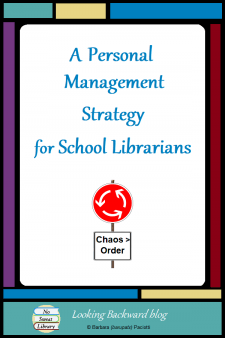 Making the most of our time is difficult when we’re pulled in so many different directions. My first two years as a new school librarian I tried applying what I’d learned in library school, but I was overwhelmed by all the “stuff” in a library besides books on the shelves—documents, equipment, supplies, tools, furniture—as well as “things I had to do” to serve students and teachers. I needed a way to organize that which was not already organized by the Dewey Decimal System and the class periods of my school day.
Making the most of our time is difficult when we’re pulled in so many different directions. My first two years as a new school librarian I tried applying what I’d learned in library school, but I was overwhelmed by all the “stuff” in a library besides books on the shelves—documents, equipment, supplies, tools, furniture—as well as “things I had to do” to serve students and teachers. I needed a way to organize that which was not already organized by the Dewey Decimal System and the class periods of my school day.
My 3rd year as a librarian a new principal—an organizational genius—suggested I first develop a Personal Management Strategy as a step toward managing the library program. So I asked myself, ‘What personal strategies can help with library management?’ and I determined 3 areas for personal management: content organization, time management, and personal philosophy.
CONTENT ORGANIZATION
I began organizing content by analyzing AASL and my State’s standards and guidelines for school libraries. That may seem an odd way to start, but those documents helped me encapsulate what I do and why I do it. As a result, I created 6 organization categories: Budget, Collection, Facility, Lessons, Library Promotion, and Professional Development. These categories became the structure for my thought processes, my filing systems (digital & print), and my library program.
I color-coded each category and articulated what belonged in them:
- Budget (hot pink) = budget/funding documents, purchasing information, and booklists for purchase.
- Collection (blue) = cataloging, circulation, inventory, and book labels.
- Facility (tan) = aides, bulletin boards, reading promotion (including book trailers & bookmarks), makerspace, physical layout, and signs/shelf labels.
- Lessons (green) = lesson planner, standards documents, library info lessons, and other lessons with school subjects.
- Library Program Administration (red) = informational handouts, presentations, reports, and library administrative handbook.
- Professional Development (purple) = meetings & trainings, and state/district appraisal documents.
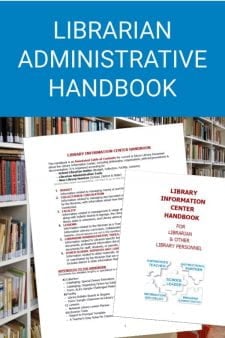 These categories fit nicely with the 5 facets of a School Librarian: as information specialist, as instructional partner, as experienced teacher, as program administrator, and as education leader. I even purchased paper, file folders, and binders in these colors to make it easier to identify print materials on my bookshelf and in my file drawers.
These categories fit nicely with the 5 facets of a School Librarian: as information specialist, as instructional partner, as experienced teacher, as program administrator, and as education leader. I even purchased paper, file folders, and binders in these colors to make it easier to identify print materials on my bookshelf and in my file drawers.
To keep my content and decisions about it organized, I created an administrative handbook, an annotated Table of Contents organized by my categories. My expandable document grows to meet my needs. If you need a handbook like this, you can find it in No Sweat Library, my TeachersPayTeachers store.
TIME MANAGEMENT
A busy librarian needs a time management tool to prioritize daily actions and meet deadlines. For me, lists bring order to chaos faster than any other tool, and spreadsheets are flexible enough to create different types of lists for different time management needs. I created a “Librarian Checklists” spreadsheet document with a worksheet tab for each different list.
BEGINNING OF YEAR Tabs
At the beginning of the school year I have many tasks to prepare myself and the library before teachers and students arrive on campus. A chronological list is perfect to organize everything and help me accomplish it in a timely manner. In my Librarian Checklists I have one tab for my ‘alone’ days before teachers arrive and another tab for the week of staff development when teachers (but no students) are on campus. Here’s an example of what’s on those two lists:
- BOY ABCs (before teachers arrive)
- Records Day – list of updates to all records for teacher/room changes in automation system, library Website, library passes, maps; update teacher information documents & reprint.
- Teacher Materials Day – list of library items to check out & deliver to teacher classrooms; troubleshoot, clean, recharge library & teacher AVD equipment.
- Library Day – list of tasks to arrange library, update signage & bulletin boards, process summer magazines & new books, update substitute folder & aide materials.
- BOY 123+ (during Staff Development Week)
- Update yearly goals/objectives for library program & PD.
- Troubleshoot/recharge student A/V/D equipment (calculators, cameras).
- Schedule with ELA teachers for orientations & book exchanges; schedule w/ teachers for student checkout of calculators for Algebra & cameras for yearbook.
- Prepare PPT announcements for new school year (cafeteria menus, clubs, etc).
TO DO Tab
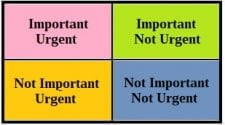 Another Librarian Checklists tab is a “To Do” list of tasks I want to accomplish during the year, such as facility changes, collection tasks, and other library or school goals as detailed in my Strategic Planning document. I use an Eisenhower Matrix (devised by Steven Covey from a quote by former President Dwight Eisenhower) to classify tasks into color-coded quadrants based on Importance and Urgency.
Another Librarian Checklists tab is a “To Do” list of tasks I want to accomplish during the year, such as facility changes, collection tasks, and other library or school goals as detailed in my Strategic Planning document. I use an Eisenhower Matrix (devised by Steven Covey from a quote by former President Dwight Eisenhower) to classify tasks into color-coded quadrants based on Importance and Urgency.
LIBRARY USE Tab
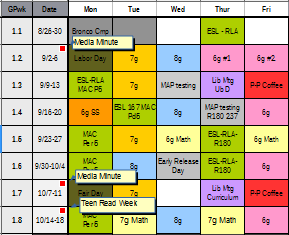 My Library Use tab is my Library Schedule. It’s a calendar of the school year, listing week numbers and dates for each grading period down the left, and a cell for each day of the week across the top. In the cross cells I record who will be in the library (or if I’ll be gone to a district meeting). I add Comment boxes to give details of lessons or library use, and I also insert Comments to remind me of timely tasks or events, such as sending my Media Minute email each month. This quick email of library news is sent to the whole staff and can be read in 1-minute or less, with a single link to additional information.
My Library Use tab is my Library Schedule. It’s a calendar of the school year, listing week numbers and dates for each grading period down the left, and a cell for each day of the week across the top. In the cross cells I record who will be in the library (or if I’ll be gone to a district meeting). I add Comment boxes to give details of lessons or library use, and I also insert Comments to remind me of timely tasks or events, such as sending my Media Minute email each month. This quick email of library news is sent to the whole staff and can be read in 1-minute or less, with a single link to additional information.
To complete my time management tool I have 3 additional Librarian Checklists tabs:
- School Schedules Tab has a copy of our master class-schedule chart, customized with color-coded teacher-conference and subject-PD periods so I know when I can visit a teacher in their classroom for lesson collaboration.
- Weeding & Inventory Tab has a chart of Dewey Subjects/Classes and Fiction Subjects with adjoining columns that show a time frame for weeding: date of last weeding, date for next weeding, and date of last inventory.
- EOY (End-Of-Year) Tab for the last month of school is another chronological list of procedures for collecting library materials from students and teachers, and closing the library for the summer.
I tend to be a procrastinator, but these 7 worksheet lists keep me on-track and it’s very convenient to have my time management lists compiled into a single spreadsheet document.
PERSONAL PHILOSOPHY
I also needed to re-clarify my own Personal Philosophy about the library program. I decided that students are the reason I am where I am, so my personal philosophy became “keep students, not the library, as the priority, and everything else will fall into place.” My personal philosophy helps me make wise professional decisions (as library director Dr. Salerno put it) that have a positive impact on students.
One of my wisest library management decisions was to eliminate overdue book fines. They just didn’t serve any positive purpose:
- Kids don’t return overdue books because they can’t pay the fine in order to check out a new book, so kids weren’t reading and books weren’t circulating.
- Even with regular book exchanges, the due date passed, and teachers didn’t always allow kids to leave class to return a book. Our kids rarely had time to go to lockers between classes.
- Poorer kids stared at their coins, trying to decide if they’d have money for lunch (or dinner on the way home) if they paid the fine; well-off kids didn’t care—they’d bring a $20 bill for a 20¢ fine and expect me to make change.
- Offering “fine forgiveness” incentives to get books returned is totally unfair to kids who’ve been paying fines.
- In my case, our public library doesn’t charge fines, even for adults, so why would a public school charge kids?
- Collecting fines was time-consuming work with little benefit, especially if an entire class is checking out books during the last 10 minutes of a period.
I don’t think fines “build responsibility” in students and I’m adamantly against fines to “raise money for the library.” That is an adult responsibility, not one for kids. And according to my personal philosophy, a kid is more important than an overdue fine. My principal agreed with all of this, so we quit charging fines for overdue books.
I have effective ways to get back overdue books, and here are some of them:
- When a students says they returned the book, I have them check the shelves to see if it’s there, because sometimes I do miss checking them in (and of course I blame the computer!).
linebreak - In our automation system, we use a field in the student’s profile for their ELA teacher. For regular Book Exchange visits near the end of a grading period, I run overdue notices by grade and sort by teacher. When the first class arrives I give teachers their notices, and they distribute them throughout the day just before kids browse for books. Many kids have their overdues in their lockers so they retrieve and return them during their browsing time.
linebreak - I have kids put an overdue notice in their shoe. (This great idea from a student.) When they get home and take off their shoes, they see the note and it reminds them to put the book by their shoes to bring back the next day.
linebreak -
I write down the overdue book title on a funny bookmark so every time they open their new book to read, it reminds them to bring back that overdue one. (Yes, they can still check out a book with an overdue. A kid is more important than a book.)
- I give kids the library phone to call their home or mobile phone and leave a reminder message. (They think this is hilarious when I tell them that’s how “Ms P” reminds herself of things!)
linebreak - For severe cases I have them call their Mom. (This is especially effective if they have to call her at work—she’s not happy, but the kid’s in the doghouse, not me!)
I’ve never regretted my “wise professional decision” to eliminate overdue book fines. It builds better PR with parents and students, and simplifies considerably the daily demands on my time and sanity.
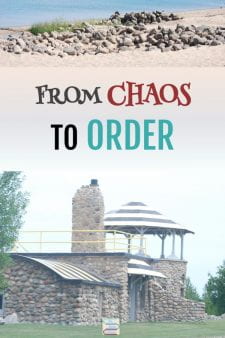 Looking back, I can say that developing my Personal Management Strategy was an important step to better library management.
Looking back, I can say that developing my Personal Management Strategy was an important step to better library management.
Once I’d organized my field of work, directed my daily activities, and confirmed what’s important to me as an educator and a school librarian, I had a method to make smarter decisions faster in order to achieve my goals.
Only after clarifying my Personal Management could I turn my attention to fully conceptualizing the management of my school library program.
![]()


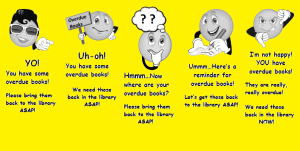


very useful document
thanks a lot for sharing
Thank you for your kind comment, Sharada.
BrP